Evolution of Habitat Quality and Its Response to Topographic Gradient Effect in a Karst Plateau: A Case Study of the Key Biodiversity Conservation Project Area of Wuling Mountains
Abstract
1. Introduction
2. Data and Methods
2.1. Study Area
2.2. Data Resources
2.3. Methods
2.3.1. Selection of Landscape Pattern Index
2.3.2. The InVEST-HQ Model
2.3.3. Terrain and Distribution Indices
3. Results
3.1. Land-Use Change Analysis
3.2. Changes in Landscape Pattern Indices
3.3. Habitat Quality during the 1990–2018 Period
3.4. Topographic Gradient Effect of Habitat Quality
4. Discussion
5. Conclusions
Author Contributions
Funding
Institutional Review Board Statement
Informed Consent Statement
Data Availability Statement
Conflicts of Interest
References
- Hall, L.S.; Krausman, P.R.; Morrison, M.L. The habitat concept and a plea for standard terminology. Wildl. Soc. Bull. 1997, 25, 173–182. [Google Scholar]
- Goldstein, J.H.; Caldarone, G.; Duarte, T.K.; Ennaanay, D.; Hannahs, N.; Mendoza, G.; Polasky, S.; Wolny, S.; Daily, G.C. Integrating ecosystem-service tradeoffs into land-use decisions. Proc. Natl. Acad. Sci. USA 2012, 109, 7565–7570. [Google Scholar] [CrossRef] [PubMed]
- Hillard, E.M.; Nielsen, C.K.; Groninger, J.W. Swamp rabbits as indicators of wildlife habitat quality in bottomland hardwood forest ecosystems. Ecol. Indic. 2017, 79, 47–53. [Google Scholar] [CrossRef]
- Fellman, J.B.; Hood, E.; Dryer, W.; Pyare, S. Stream physical characteristics impact habitat quality for Pacific salmon in two temperate coastal watersheds. PLoS ONE 2015, 10, e0132652. [Google Scholar] [CrossRef] [PubMed]
- Berta Aneseyee, A.; Noszczyk, T.; Soromessa, T.; Elias, E. The InVEST habitat quality model associated with land use/cover changes: A qualitative case study of the Winike Watershed in the Omo-Gibe Basin, Southwest Ethiopia. Remote Sens. 2020, 12, 1103. [Google Scholar] [CrossRef]
- Kija, H.K.; Ogutu, J.O.; Mangewa, L.J.; Bukombe, J.; Verones, F.; Graae, B.J.; Kideghesho, J.R.; Said, M.Y.; Nzunda, E.F. Spatio-temporal changes in wildlife habitat quality in the greater Serengeti ecosystem. Sustainability 2020, 12, 2440. [Google Scholar] [CrossRef]
- Di Febbraro, M.; Sallustio, L.; Vizzarri, M.; De Rosa, D.; De Lisio, L.; Loy, A.; Eichelberger, B.; Marchetti, M. Expert-based and correlative models to map habitat quality: Which gives better support to conservation planning? Glob. Ecol. Conserv. 2018, 16, e00513. [Google Scholar] [CrossRef]
- Chaplin-Kramer, R.; Sharp, R.P.; Mandle, L.; Sim, S.; Johnson, J.; Butnar, I.; Milà i Canals, L.; Eichelberger, B.A.; Ramler, I.; Mueller, C.; et al. Spatial patterns of agricultural expansion determine impacts on biodiversity and carbon storage. Proc. Natl. Acad. Sci. USA 2015, 112, 7402–7407. [Google Scholar] [CrossRef]
- Sweetman, C.; Ezpeleta, M. Introduction: Natural resource justice. Gend. Dev. 2017, 25, 353–366. [Google Scholar] [CrossRef]
- Otto, C.R.; Roth, C.L.; Carlson, B.L.; Smart, M.D. Land-use change reduces habitat suitability for supporting managed honey bee colonies in the Northern Great Plains. Proc. Natl. Acad. Sci. USA 2016, 113, 10430–10435. [Google Scholar] [CrossRef]
- Zhao, G.; Liu, J.; Kuang, W.; Ouyang, Z.; Xie, Z. Disturbance impacts of land use change on biodiversity conservation priority areas across China: 1990–2010. J. Geogr. Sci. 2015, 25, 515–529. [Google Scholar] [CrossRef]
- Li, S.-P.; Liu, J.-L.; Lin, J.; Fan, S.-L. Spatial and temporal evolution of habitat quality in Fujian Province, China based on the land use change from 1980 to 2018. Ying Yong Sheng Tai Xue Bao J. Appl. Ecol. 2020, 31, 4080–4090. [Google Scholar] [CrossRef]
- Wu, J.S.; Cao, Q.W.; Shi, S.Q.; Huang, X.L.; Lu, Z.Q. Spatio-temporal variability of habitat quality in Beijing-Tianjin-Hebei Area based on land use change. Ying Yong Sheng Tai Xue Bao J. Appl. Ecol. 2015, 26, 3457–3466. [Google Scholar] [CrossRef]
- Janus, J.; Bozek, P. Land abandonment in Poland after the collapse of socialism: Over a quarter of a century of increasing tree cover on agricultural land. Ecol. Eng. 2019, 138, 106–117. [Google Scholar] [CrossRef]
- Polasky, S.; Nelson, E.; Pennington, D.; Johnson, K.A. The impact of land-use change on ecosystem services, biodiversity and returns to landowners: A case study in the state of Minnesota. Environ. Resour. Econ. 2011, 48, 219–242. [Google Scholar] [CrossRef]
- Reis, E.; López-Iborra, G.M.; Pinheiro, R.T. Changes in bird species richness through different levels of urbanization: Implications for biodiversity conservation and garden design in Central Brazil. Landsc. Urban Plan. 2012, 107, 31–42. [Google Scholar] [CrossRef]
- Zhu, C.; Zhang, X.; Zhou, M.; He, S.; Gan, M.; Yang, L.; Wang, K. Impacts of urbanization and landscape pattern on habitat quality using OLS and GWR models in Hangzhou, China. Ecol. Indic. 2020, 117, 106654. [Google Scholar] [CrossRef]
- Liu, H.-Y.; Li, Z.-F.; Bai, Y.-F. Landscape simulating of habitat quality change for oriental white stork in Naoli River Watershed. Acta Ecol. Sin. 2006, 26, 4007–4013. [Google Scholar] [CrossRef]
- Sherrouse, B.C.; Semmens, D.J.; Clement, J.M. An application of Social Values for Ecosystem Services (SolVES) to three national forests in Colorado and Wyoming. Ecol. Indic. 2014, 36, 68–79. [Google Scholar] [CrossRef]
- Feng, S.; Sun, R.; Chen, L. Spatio-temporal variability of habitat quality based on land use pattern change in Beijing. Acta Ecol. Sin. 2018, 38, 4167–4179. [Google Scholar] [CrossRef]
- Sallustio, L.; De Toni, A.; Strollo, A.; Di Febbraro, M.; Gissi, E.; Casella, L.; Geneletti, D.; Munafò, M.; Vizzarri, M.; Marchetti, M. Assessing habitat quality in relation to the spatial distribution of protected areas in Italy. J. Environ. Manag. 2017, 201, 129–137. [Google Scholar] [CrossRef] [PubMed]
- Liu, C.; Wang, C. Spatio-temporal evolution characteristics of habitat quality in the Loess Hilly Region based on land use change: A case study in Yuzhong County. Acta Ecol. Sin. 2018, 38, 7300–7311. [Google Scholar] [CrossRef]
- Xu, C.; Gong, J.; Li, Y.; Yan, L.; Gao, B. Spatial distribution characteristics of typical ecosystem services based on terrain gradients of Bailongjiang Watershed in Gansu. Acta. Ecol. Sin. 2020, 40, 4291–4301. [Google Scholar] [CrossRef]
- Zhang, Z.; Zinda, J.A.; Yang, Z.; Yin, M.; Ou, X.; Xu, Q.; Yu, Q. Effects of topographic attributes on landscape pattern metrics based on redundancy ordination gradient analysis. Landsc. Ecol. Eng. 2018, 14, 67–77. [Google Scholar] [CrossRef]
- Bai, L.-M.; Feng, X.-H.; Sun, R.-F.; Gao, H. Spatial and temporal responses of habitat quality to urbanization: A case study of Changchun City, Jilin Province, China. Ying Yong Sheng Tai Xue Bao J. Appl. Ecol. 2020, 31, 1267–1277. [Google Scholar] [CrossRef]
- Chen, Z.; Huang, Y.B.; Zhu, Z.P.; Zheng, Q.Q.; Que, C.X.; Dong, J.W. Landscape pattern evolution along terrain gradient in Fuzhou City, Fujian Province, China. Ying Yong Sheng Tai Xue Bao J. Appl. Ecol. 2018, 29, 4135–4144. [Google Scholar] [CrossRef]
- Liu, Z.; Tang, L.; Qiu, Q.; Xiao, L.; Xu, T.; Yang, L. Temporal and spatial changes in habitat quality based on land-use change in Fujian Province. Acta Ecol. Sin. 2017, 37, 4538–4548. [Google Scholar] [CrossRef]
- Husen, A.; Mishra, V.; Semwal, K.; Kumar, D. Biodiversity status in Ethiopia and challenges. In Environmental Pollution and Biodiversity Chapter: Biodiversity Status in Ethiopia and Challenges; Bharati, K.P., Chauhan, A., Kumar, P., Eds.; Publishing House Pvt Ltd.: New Delhi, India, 2012; Volume 1, pp. 31–79. [Google Scholar] [CrossRef]
- Terrado, M.; Sabater, S.; Chaplin-Kramer, B.; Mandle, L.; Ziv, G.; Acuña, V. Model development for the assessment of terrestrial and aquatic habitat quality in conservation planning. Sci. Total Environ. 2016, 540, 63–70. [Google Scholar] [CrossRef]
- Ahrends, A.; Hollingsworth, P.M.; Ziegler, A.D.; Fox, J.M.; Chen, H.; Su, Y.; Xu, J.J.G.E.C. Current trends of rubber plantation expansion may threaten biodiversity and livelihoods. Glob. Environ. Chang. 2015, 34, 48–58. [Google Scholar] [CrossRef]
- Shuangao, W.; Padmanaban, R.; Mbanze, A.A.; Silva, J.M.; Shamsudeen, M.; Cabral, P.; Campos, F.S. Using satellite image fusion to evaluate the impact of land use changes on ecosystem services and their economic values. Remote Sens. 2021, 13, 851. [Google Scholar] [CrossRef]
- Saura, S.; Torné, J. Conefor Sensinode 2.2: A software package for quantifying the importance of habitat patches for landscape connectivity. Environ. Model. Softw. 2009, 24, 135–139. [Google Scholar] [CrossRef]
- Xie, Y.; Yu, M.; Bai, Y.; Xing, X. Ecological analysis of an emerging urban landscape pattern—Desakota: A case study in Suzhou, China. Landsc. Ecol. 2006, 21, 1297–1309. [Google Scholar] [CrossRef]
- Zhao, D.; Zeng, Y. Land use changes and ecological risk assessment in eastern Qinghai Plateau: A case study in Haidong, Qinghai. J. Desert Res. 2016, 36, 1190–1197. [Google Scholar] [CrossRef]
- Sharp, R.; Tallis, H.T.; Ricketts, T.; Guerry, A.D.; Wood, S.A.; Chaplin-Kramer, R.; Nelson, E.; Ennaanay, D.; Wolny, S.; Olwero, N.; et al. InVEST 3.5.0 User’s Guide. The Natural Capital Project; Stanford University: Stanford, CA, USA, 2014. [Google Scholar]
- Huang, X.; Yang, Y.; Wu, Y.; Gao, Y.; Gu, Y.; Yuan, Z. Land use change and its impact on habitat quality in karst nature reserve from 1990 to 2017. J. Lake Sci. 2018, 38, 345–351. [Google Scholar]
- Liu, C.; Zhou, G.; Huang, Q. Spatio-temporal evolution analysis of habitat quality in the mountainous watershed of southwest based on InVEST model: A case study of Chishui River Basin in Guizhou province [J/OL]. JYR 2021, 1–12. [Google Scholar]
- Yu, H.; Zeng, H.; Jiang, Z. Study on distribution characteristics of landscape elements along the terrain gradient. Sci. Geogr. Sin. 2001, 21, 64–69. [Google Scholar]
- Muyi, H.; Yue, W.; Feng, S.; Zhang, J. Spatial-temporal evolution of habitat quality and analysis of landscape patterns in Dabie Mountain area of west Anhui province based on InVEST model. Acta Ecol. Sin. 2020, 40, 2895–2906. [Google Scholar] [CrossRef]
- Li, X.; Bu, R.; Chang, Y.; Hu, Y.; Wen, Q.; Wang, X.; Xu, C.; Li, Y.; He, H. The response of landscape metrics against pattern scenarios. Acta Ecol. Sin. 2004, 24, 123–134. [Google Scholar] [CrossRef]
- Wu, A.; Liu, X.; Zhao, Y. Environment. The distribution and change of the land use types in hilly region based on terrain features. J. Arid. Land Resour. Environ. 2015, 29, 181–185. [Google Scholar] [CrossRef]
- Liu, S.; Yin, Y.; Yang, Y.; An, N.; Wang, C.; Dong, S. Assessment of the influences of landscape fragmentation on regional habitat quality in the Manwan Basin. Acta Ecol. Sin. 2017, 37, 619–627. [Google Scholar]
- Han, H.; Yang, G.; Zhang, F. Spatio-temporal analysis of land use changes in Guizhou Province based on landform characteristics. J. Nanjing Univ. 2015, 39, 99–105. [Google Scholar] [CrossRef]
- Hang, H.T.; Wu, Y.; Zhang, K.Y.; Tan, D.J.; Lu, N.; Min, X.Y.; Guo, T.; Chen, L. Effects of simulated karst soil habitat stresses on photosynthetic characteristics and dry matter allocation of Robinia pseudoacacia seedlings. JCJOE 2019. [CrossRef]
- Luo, G.; Wang, S.; Li, Y.; Bai, X. Spatio-temporal dynamics and ecological service function assessment of slope farmland in Karst areas of Guizhou province, China. Trans. Chin. Soc. Agric. Eng. 2014, 30, 233–243. [Google Scholar] [CrossRef]
- Gao, L.; Zhao, Z.; Zhang, H.; Xuebin, G.; Xiao, M. Adjustment of Haikou city ecosystem services value based on habitat quality and ecological location. Beijing Da Xue Xue Bao. Zi Ran Ke Xue Bao 2012, 48, 833–840. [Google Scholar]
- Su, C.; Zhang, X.; Ma, W. Altitudinal pattern and environmental interpretation of species diversity of shrub communty in the Helan Mountains. China 2018, 36, 699–708. [Google Scholar] [CrossRef]
- Wu, N.; Song, X.; Kang, W.; Deng, X.; Hu, X.; Shi, P.; Liu, Y.J. Standard of payment for ecosystem services in a watershed based on InVEST model under different standpoints: A case study of the Weihe River in Gansu Province. Acta Ecol. Sin. 2018, 38, 2512–2522. [Google Scholar]
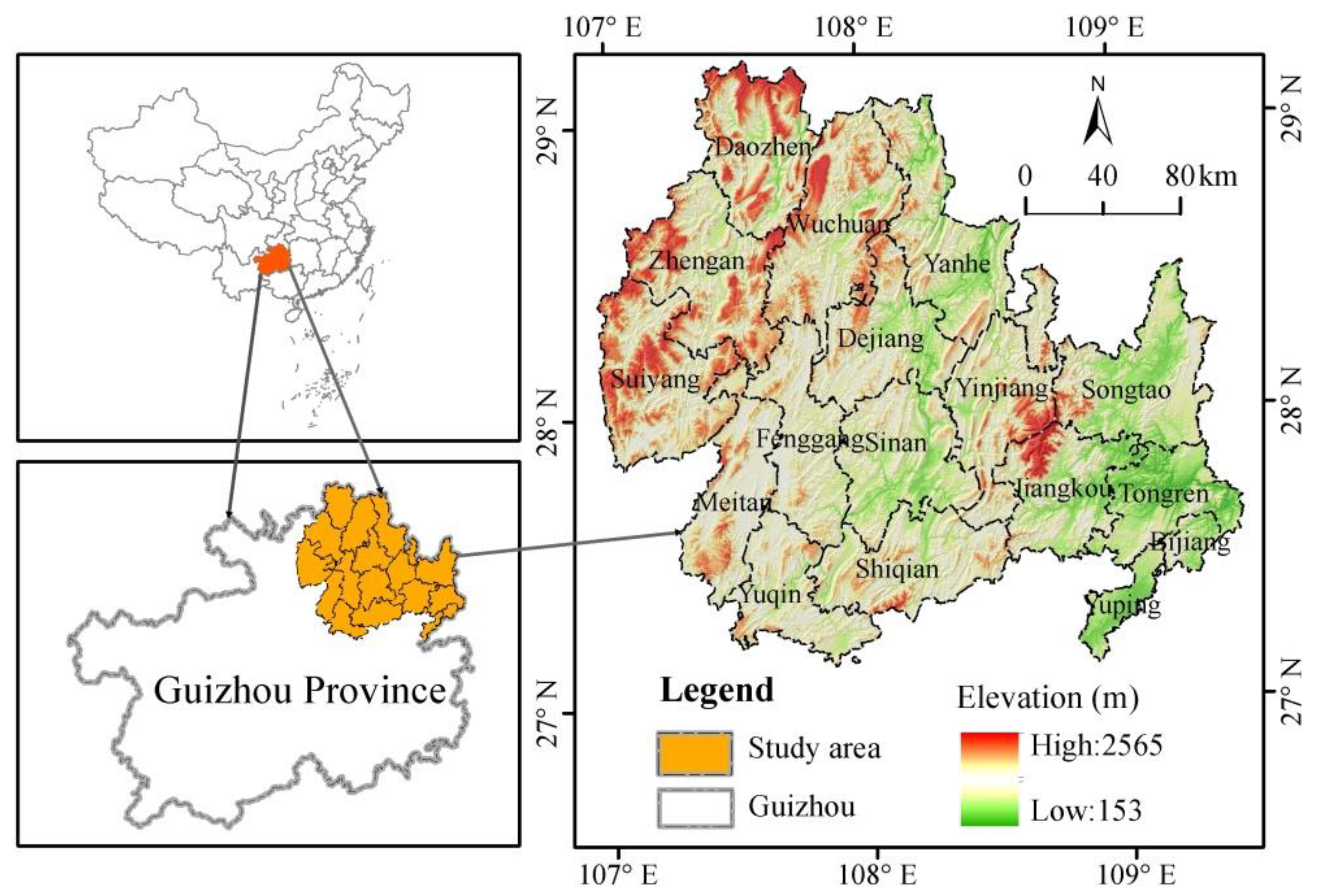


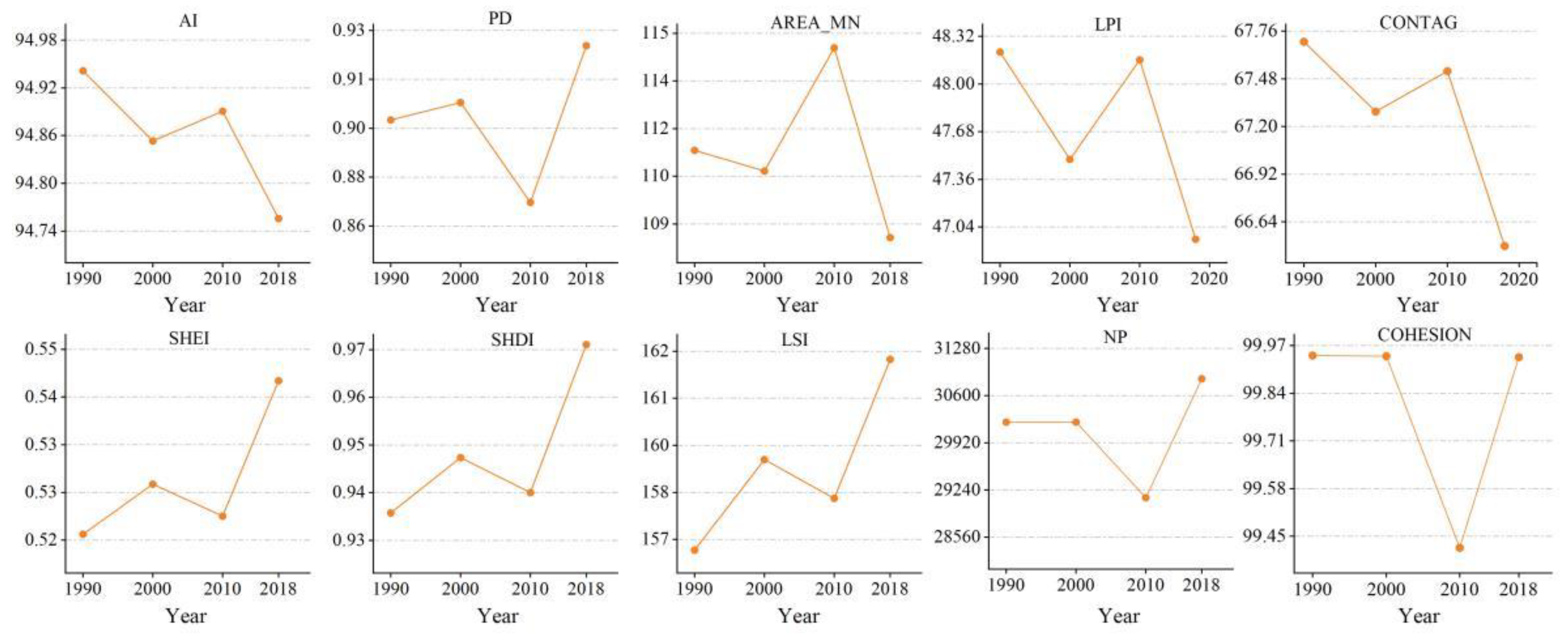
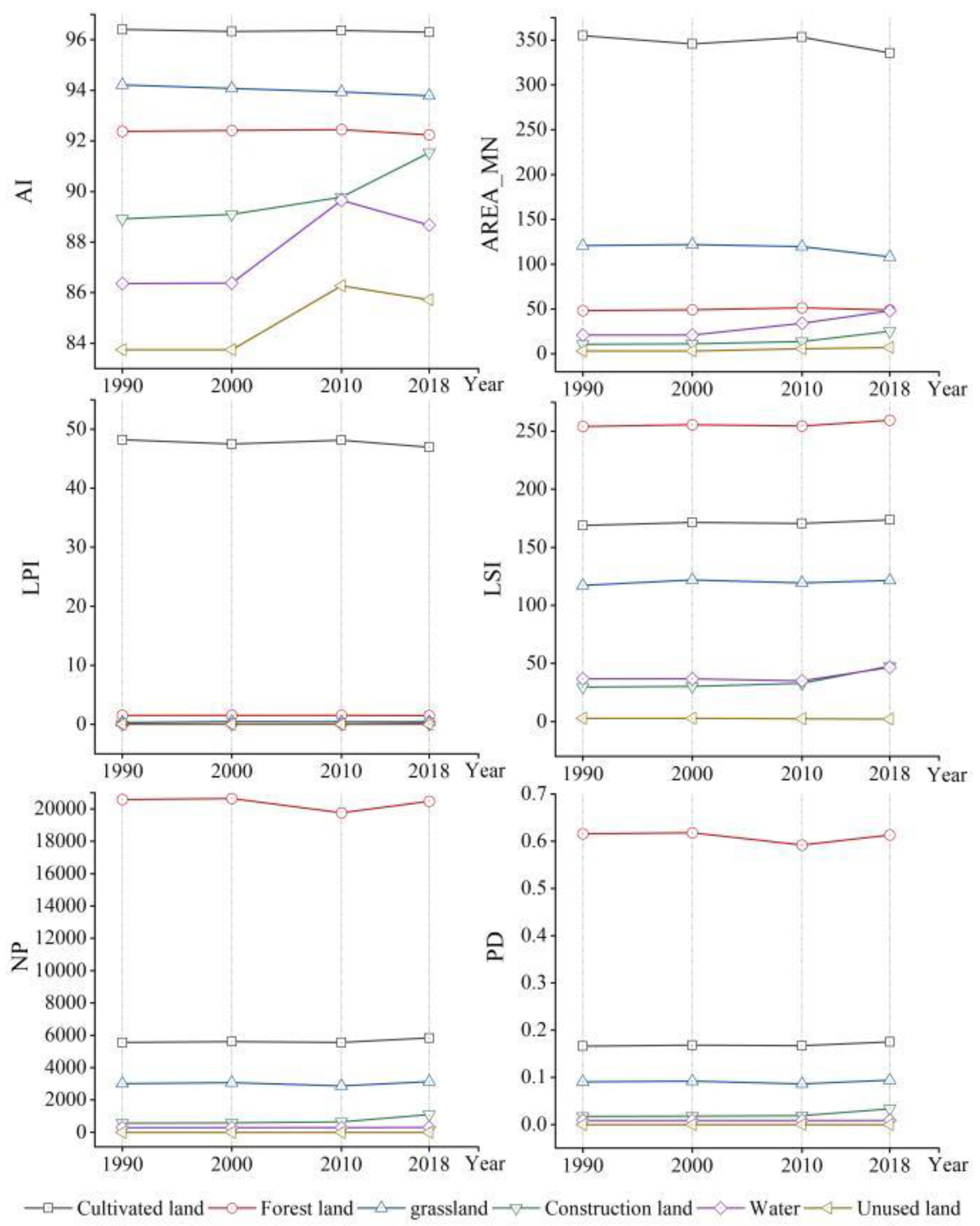

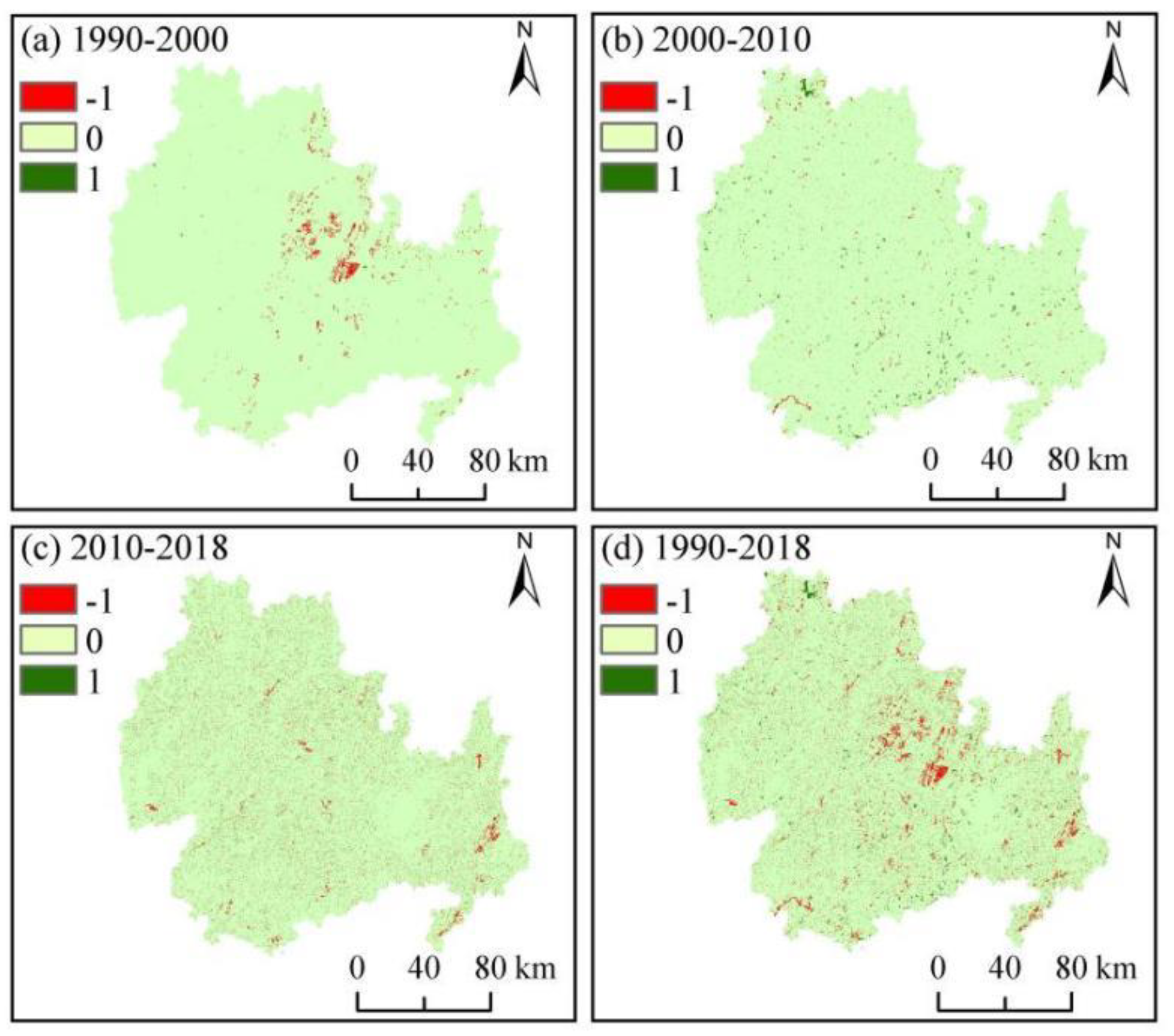
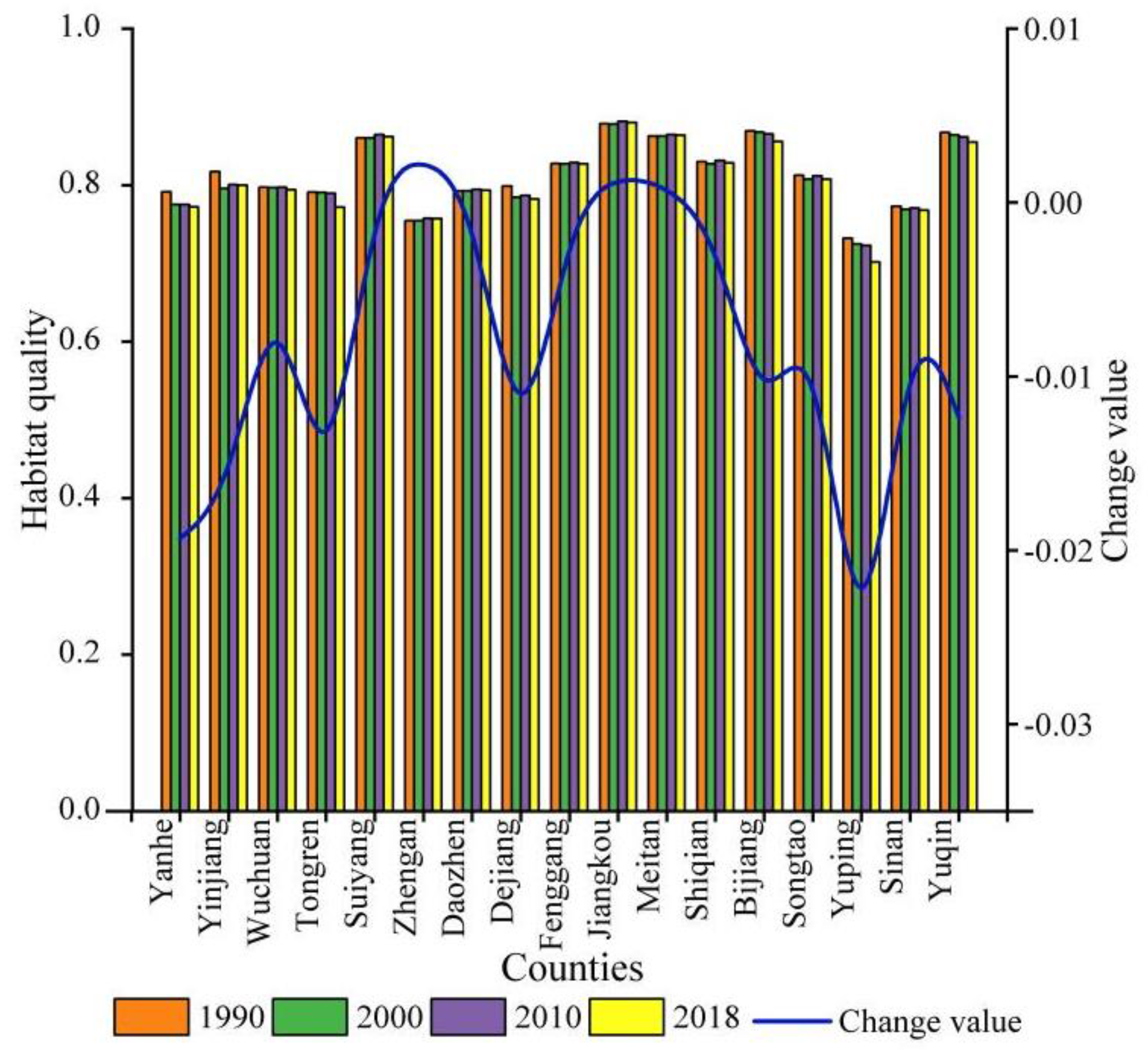


| Primary Land-Use Type | Secondary Land-Use Type |
|---|---|
| Cultivated land | Paddy land, Dry land |
| Forest land | Forest, Shrub, Open Forest, Other forests |
| Grassland | High-coverage grassland, Moderate-coverage grassland, Low-coverage grassland |
| Water | River canalization, Lake, Reservoir and Pond, Beach land |
| Construction land | Urban land, Rural settlement, Other Construction land |
| Unused land | Bare land |
| Threat Factors | Max Distance of Influence/km | Weights | Decay Type |
|---|---|---|---|
| Cultivated land | 5 | 0.7 | Linear |
| Urban land use | 8 | 1.0 | Exponential |
| Rural settlements | 5 | 0.6 | Exponential |
| Other construction land | 3 | 0.5 | Exponential |
| Land Code | Land-Use Type | Habitat Suitability | Cultivated Land | Urban Land Use | Rural Settlements | Other Construction Land |
|---|---|---|---|---|---|---|
| 11 | CL | 0.5 | 0 | 0.7 | 0.6 | 0.5 |
| 12 | FL | 1 | 0.8 | 0.85 | 0.9 | 0.6 |
| 21 | SL | 1 | 0.5 | 0.6 | 0.65 | 0.5 |
| 22 | OFL | 1 | 0.9 | 0.8 | 0.9 | 0.7 |
| 23 | OWL | 1 | 0.9 | 0.85 | 0.85 | 0.7 |
| 24 | HCG | 0.8 | 0.6 | 0.6 | 0.55 | 0.2 |
| 31 | MCG | 0.7 | 0.55 | 0.7 | 0.5 | 0.3 |
| 32 | LCG | 0.6 | 0.5 | 0.6 | 0.5 | 0.4 |
| 33 | RC | 0.8 | 0.6 | 0.6 | 0.5 | 0.3 |
| 41 | LK | 0.9 | 0.65 | 0.75 | 0.65 | 0.4 |
| 42 | RP | 0.7 | 0.6 | 0.6 | 0.5 | 0.5 |
| 43 | BL | 0.6 | 0.6 | 0.7 | 0.65 | 0.5 |
| 51 | UL | 0 | 0 | 0 | 0 | 0 |
| 52 | RS | 0 | 0 | 0 | 0 | 0 |
| 53 | OCL | 0 | 0 | 0 | 0 | 0 |
| 66 | BL | 0 | 0 | 0 | 0 | 0 |
| Year | Cultivated Land | Grassland | Forestland | Water | Construction Land | Unused Land | ||||||
|---|---|---|---|---|---|---|---|---|---|---|---|---|
| km2 | % | km2 | % | km2 | % | km2 | % | km2 | % | km2 | % | |
| 1990 | 9928.0 | 29.71 | 3638.8 | 10.89 | 19,723.0 | 59.02 | 62.4 | 0.19 | 60.8 | 0.18 | 0.12 | 0.00 |
| 2000 | 10,148.9 | 30.37 | 3751.9 | 11.23 | 19,383.6 | 58.01 | 62.7 | 0.19 | 65.9 | 0.20 | 0.12 | 0.00 |
| 2010 | 10,134.4 | 30.33 | 3433.3 | 10.30 | 19,659.9 | 58.84 | 97.8 | 0.29 | 88.0 | 0.26 | 0.11 | 0.00 |
| 2018 | 10,005.0 | 29.94 | 3397.8 | 10.17 | 19,588.6 | 58.63 | 147.1 | 0.44 | 274.8 | 0.82 | 0.07 | 0.00 |
| Year | Land-Use Type | Grassland | Cultivated Land | Construction Land | Forestland | Water | Unused Land |
|---|---|---|---|---|---|---|---|
| 1990–2000 | grassland | 3560.53 | 68.47 | 0.98 | 8.77 | 0.00 | 0.00 |
| Cultivated land | 0.49 | 9919.82 | 4.13 | 3.20 | 0.32 | 0.00 | |
| Construction land | 0.00 | 0.00 | 60.78 | 0.00 | 0.00 | 0.00 | |
| Forestland | 190.82 | 160.54 | 0.03 | 19,371.56 | 0.00 | 0.00 | |
| Water | 0.00 | 0.00 | 0.00 | 0.01 | 62.36 | 0.00 | |
| Unused land | 0.00 | 0.00 | 0.00 | 0.00 | 0.00 | 0.12 | |
| 2000–2010 | grassland | 3360.78 | 110.89 | 2.97 | 275.41 | 1.47 | 0.00 |
| Cultivated land | 50.36 | 9851.19 | 11.97 | 223.88 | 11.16 | 0.00 | |
| Construction land | 0.13 | 1.04 | 64.30 | 0.31 | 0.13 | 0.00 | |
| Forestland | 21.54 | 170.18 | 8.67 | 19,157.54 | 24.00 | 0.00 | |
| Water | 0.19 | 0.63 | 0.05 | 0.78 | 60.96 | 0.00 | |
| Unused land | 0.00 | 0.00 | 0.00 | 0.00 | 0.00 | 0.11 | |
| 2010–2018 | grassland | 3216.96 | 113.51 | 34.92 | 61.33 | 5.23 | 0.00 |
| Cultivated land | 110.89 | 9345.51 | 124.27 | 532.47 | 19.53 | 0.00 | |
| Construction land | 0.99 | 4.30 | 80.21 | 1.84 | 0.61 | 0.00 | |
| Forestland | 66.92 | 537.55 | 34.82 | 18,980.53 | 31.95 | 0.00 | |
| Water | 0.65 | 2.51 | 0.55 | 4.50 | 89.24 | 0.00 | |
| Unused land | 0.00 | 0.00 | 0.00 | 0.00 | 0.04 | 0.05 |
| HQ Grades | Value range | 1990 | 2000 | 2010 | 2018 | Change/% |
|---|---|---|---|---|---|---|
| Proportion/% | Proportion/% | Proportion/% | Proportion/% | |||
| Low | 0–0.25 | 0.36% | 0.37% | 0.44% | 0.99% | 0.63 |
| Medium | 0.25–0.5 | 29.66% | 30.32% | 30.28% | 29.89% | 0.23 |
| Relatively high | 0.5–0.75 | 9.92% | 10.26% | 9.56% | 9.51% | −0.4 |
| High | 0.75–1 | 60.06% | 59.05% | 59.73% | 59.60% | −0.46 |
| Mean HQ | 0.812 | 0.807 | 0.809 | 0.805 | −0.007 | |
Disclaimer/Publisher’s Note: The statements, opinions and data contained in all publications are solely those of the individual author(s) and contributor(s) and not of MDPI and/or the editor(s). MDPI and/or the editor(s) disclaim responsibility for any injury to people or property resulting from any ideas, methods, instructions or products referred to in the content. |
© 2022 by the authors. Licensee MDPI, Basel, Switzerland. This article is an open access article distributed under the terms and conditions of the Creative Commons Attribution (CC BY) license (https://creativecommons.org/licenses/by/4.0/).
Share and Cite
Xie, B.; Meng, S.; Zhang, M. Evolution of Habitat Quality and Its Response to Topographic Gradient Effect in a Karst Plateau: A Case Study of the Key Biodiversity Conservation Project Area of Wuling Mountains. Int. J. Environ. Res. Public Health 2023, 20, 331. https://doi.org/10.3390/ijerph20010331
Xie B, Meng S, Zhang M. Evolution of Habitat Quality and Its Response to Topographic Gradient Effect in a Karst Plateau: A Case Study of the Key Biodiversity Conservation Project Area of Wuling Mountains. International Journal of Environmental Research and Public Health. 2023; 20(1):331. https://doi.org/10.3390/ijerph20010331
Chicago/Turabian StyleXie, Bo, Shunbing Meng, and Mingming Zhang. 2023. "Evolution of Habitat Quality and Its Response to Topographic Gradient Effect in a Karst Plateau: A Case Study of the Key Biodiversity Conservation Project Area of Wuling Mountains" International Journal of Environmental Research and Public Health 20, no. 1: 331. https://doi.org/10.3390/ijerph20010331
APA StyleXie, B., Meng, S., & Zhang, M. (2023). Evolution of Habitat Quality and Its Response to Topographic Gradient Effect in a Karst Plateau: A Case Study of the Key Biodiversity Conservation Project Area of Wuling Mountains. International Journal of Environmental Research and Public Health, 20(1), 331. https://doi.org/10.3390/ijerph20010331






